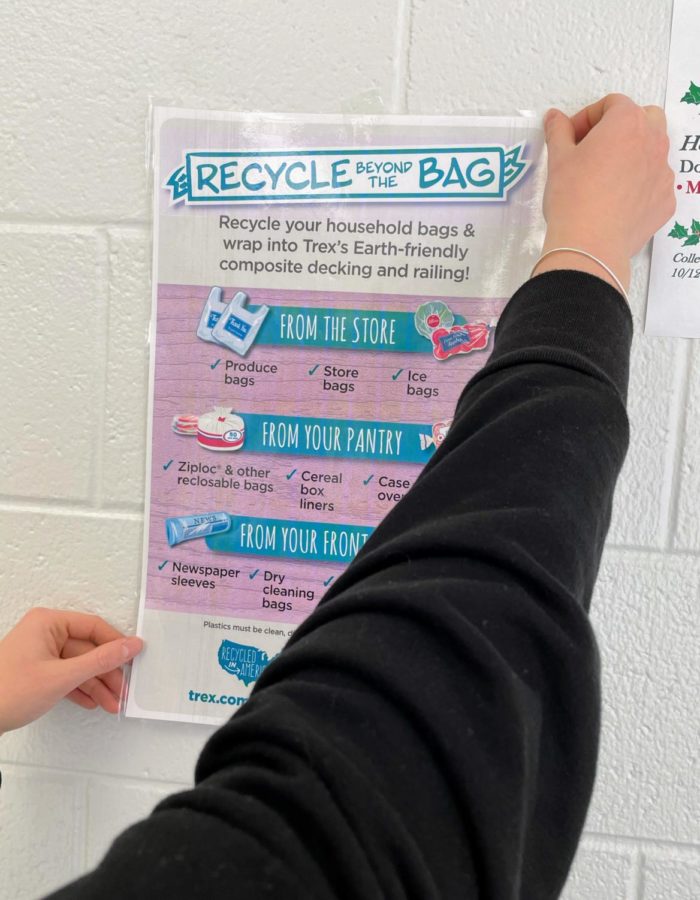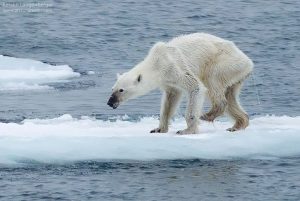Through projects, awareness, students combat climate change
The Students for Environmental Awareness club hangs posters on ways students can contribute to Trex, an environmentally friendly company that manufactures outdoor items from recycled materials
December 26, 2021
Over 1.2 million people were displaced from their homes in America due to climate change in 2020, according to the Urban Wire. Considering the ongoing California wildfires and other environmental disasters, the United Nations states that the world has until 2030 to limit the rise in global temperatures before the effects of climate change become irreversible.
“If we don’t do something in the next 10 years, [then] there will be nothing we can do,” senior Alyssa Dausch said. “There’s a very short timeline and a very quick turnaround that we need to reach if we have any hope of saving the Earth.”
At the recent Conference of the Parties (COP26) during November, the United Nations pledged to conserve 13 million square miles of forests and help accelerate their restoration. The US and eleven other countries also agreed to donate around $400 million to the Least Developed Countries Fund, which was created to help underdeveloped countries adapt to the detrimental effects of climate change.
“There’s been a lot of [conferences about climate change] over the past 20 years or so,” science teacher Anne Fenton said. “It’s frustrating that we seem to know what to do [about it], but have not [yet] implemented some of those changes.”
The Biden administration announced at COP26 that the Build Back Better Framework will combat climate change by cutting greenhouse gas pollution and investing in a clean energy economy. He also announced the Bipartisan Infrastructure Deal, created to strengthen resilience to severe climate changes.
“[These plans] are a step in the right direction,” Fenton said. “There are not enough fossil fuels to last us for much longer.”
One opportunity for students to help combat climate change is by joining the Students for Environmental Awareness (SEA) club, which has created posters to spread awareness about actions contributing to climate change, including fast fashion, improper mask disposal and littering.
“The more people there are [advocating], the more people there are to spread the word,” Dausch said. “That’s how [movements] start.”
SEA has also organized many programs that promote environmentally friendly actions. Students brought in reusable bottles and mugs for Mug Madness, an initiative to prevent harmful pollution caused by plastic bottles and single use cups. They also collected plastic for Trex, a company that uses recyclable materials to manufacture outdoor items such as railing and alternative composite decks. Future projects for SEA include a recycling competition between different schools, watershed cleanups and hosting speakers.
“We all have a common goal of promoting environmentalism and protecting the environment,” SEA president and senior Lili Malatinszky said. “[SEA] is a good way to get involved in small steps.”
An organization outside the school that students can join is the Virginia Youth Climate Cooperative (VAYCC), a grassroots climate organization focused on passing legislation through lobbying and divestment work.
“VAYCC spoke with us last year for [SEA],” Malatinkszky said. “It’s a really good way to get involved if you’re interested in changing the rules and not just as an individual.”
Some policies that VAYCC is pushing for include decreasing natural gas consumption in Virginia by 20% by 2030 and employing bio-energy with carbon capture and storage. Carbon capture and storage is the process of capturing carbon before it enters the atmosphere and utilizing carbon mineralization as a form of reusable energy. If passed, alternative energy resources such as nuclear or renewable sources would be installed and carbon capture and storage technologies would be established near fossil fuel plants to prevent greenhouse gases from being released into the air.
Students can advocate for change by organizing and signing petitions, attending protests and sending letters to Virginia state legislators. These actions spread awareness, provide donations to nonprofits, increase dedication to critical issues and pass new policies.
“There are so many young people that are making so much noise and hopefully [they will] get a hold of the older crowd,” Fenton said. “[The older audience] will pay attention; they’ll listen, they’ll read and hopefully they will respond.”






